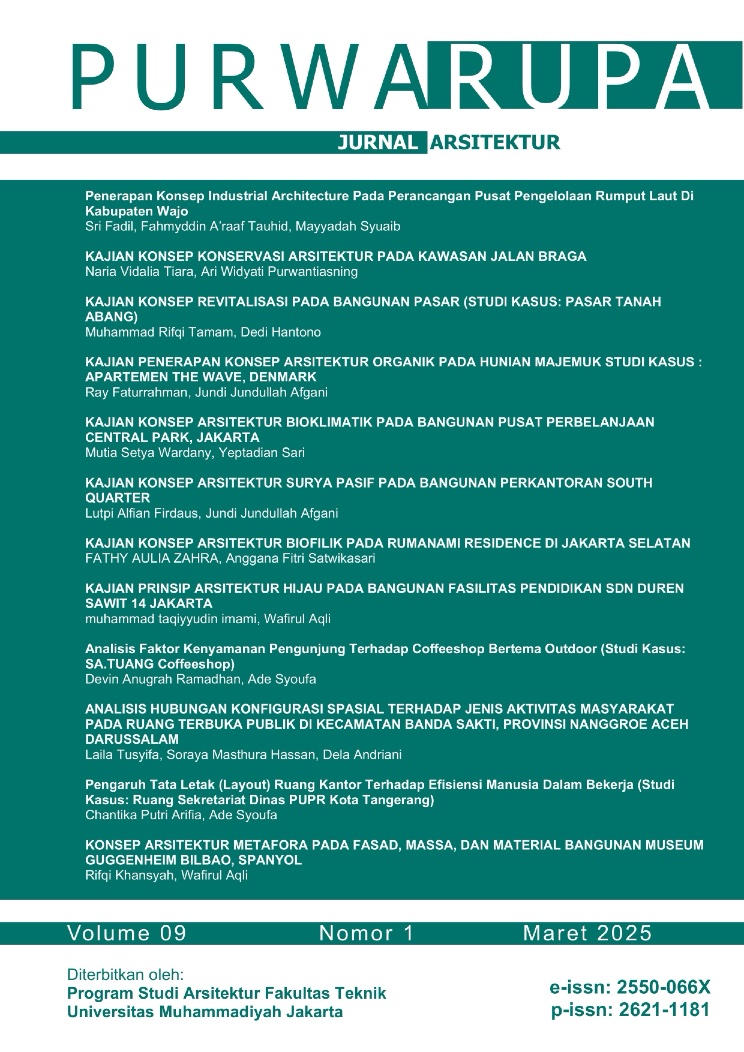Pengaruh Tata Letak (Layout) Ruang Kantor Terhadap Efisiensi Manusia Dalam Bekerja (Studi Kasus: Ruang Sekretariat Dinas PUPR Kota Tangerang)
Abstract
ABSTRAK. Manusia sebagai makhluk sosial terlibat dalam rutinitas pekerjaan, khususnya di lingkungan kantor yang menjadi tempat penting untuk melaksanakan kegiatan organisasional. Tata letak ruang kerja memengaruhi dan membuat kepribadian secara intelektual, fisik, dan psikologis pada setiap individu. Sebuah tata letak yang efektif mencerminkan berbagai faktor penting, termasuk fungsionalitas, keamanan, dan kenyamanan. Penelitian ini menggunakan metode deskriptif dengan pendekatan analisis kualitatif untuk memahami dampak tata letak ruang kantor terhadap efisiensi kerja manusia. Fokus penelitian ini terletak pada analisis dampak tata letak terhadap efisiensi manusia serta identifikasi faktor-faktor yang memengaruhi penataan ruang kantor. Sekretariat Dinas PUPR Kota Tangerang menerapkan tata letak kantor yang mencakup ruang terbuka dan ruang berkamar. Penempatan ruang tamu di tengah ruangan dianggap tidak efektif dan mengakibatkan gangguan dalam pelaksanaan tugas pegawai. Oleh karena itu, disarankan agar Dinas PUPR Kota Tangerang melakukan penyesuaian tata letak kantor di Ruang Sekretariat. Kata Kunci: Tata Letak, Efisiensi, Ruang Kantor ABSTRACT. Humans as social beings are involved in work routines, especially in an office environment which is an important place to carry out organizational activities. The layout of the workspace influences and makes a personality intellectually, physically and psychologically in each individual. An effective layout reflects various important factors, including functionality, safety, and comfort. This research uses a descriptive method with a qualitative analysis approach to understand the impact of office space layout on human work efficiency. The focus of this research lies on analyzing the impact of layout on human efficiency as well as identifying factors that influence the arrangement of office space. The Secretariat of the PUPR Office of Tangerang City applies an office layout that includes open spaces and rooms. The placement of the living room in the middle of the room is considered ineffective and causes interference in the implementation of employee tasks. Therefore, it is recommended that the Tangerang City PUPR Agency adjust the office layout in the Secretariat Room. Keywords: Layout, Efficiency, Office SpaceReferences
Arikunto, S. (2013). Prosedur Penelitian: Suatu Pendekatan Praktik. Jakarta: Rineka Cipta.
Gie, T.L. (1992). Administrasi Perkantoran Modern. Jakarta: Erlangga.
Gie, T.L. (2007). Administrasi Perkantoran Modren. Yogyakarta: Liberty.
Gie, T.L. (2012). Efisiensi Kerja. Jakarta: Erlangga.
Heizer Jay, Render Barry. (2005). Operations Management. Jakarta: Salemba Empat.
Ibrahim, Mar'ie, Lisbeth Mananeke, and Djurwati Soepeno. (2018). “Analisis Tata Letak Ruang Dan Fungsionalitas Restoran Rumah Kopi Billy Terhadap Kepuasan Pelanggan.” Jurnal EMBA: Jurnal Riset Ekonomi, Manajemen, Bisnis dan Akuntansi 6(4): 3573–3582.
Lexy J. Moleong. (2018). Metodologi Penelitian Kualitatif. (Edisi Revi, P. 410).
Mar'ie Ibrahim. (2018). Analisis Tata Letak (Layout) Pada Restoran Rumah Kopi Billy Terhadap Kepuasan Pelanggan. Jurnal: Jejak, Vol.1, No.1, September 2018.
Maryati. (2008). Manajemen Perkantoran efektif. Yogyakarta: Unit Penerbit dan Percetakan Sekolah Tinggi Ilmu Manajemen YKPN.
Nurasih, L., & Rahayu, S. (2014). Manajemen Sekretaris Itu Gampang Secara Otodidak. Dunia Cerdas.
Rahmawati N. (2020). Kualitas Akustik Ruang Utama Masjid Siti Aisyah Surakarta. Sinektika Jurnal Arsitektur.
Setiowati. (2016). Pengaruh Tata Letak Ruang Kantor dan Plant Climate Terhadap Kinerja Karyawan pada PT. Bank OCBC NISP, Tbk Cabang Pematangsiantar. Jurnal Ilmiah, 2(1), 1-10.
Sukoco, M, Badri. (2007). Manajemen Administrasi Perkantoran Modern. Surabaya: Erlangga.
Ulbert Silalahi. (1997). Studi Tentang Ilmu Administrasi. Bandung: Sinar Baru
Quible, Z. (2001). "Administrative Functions in Modern Office Management". Journal of Administrative Sciences, 1(1), 1-10.
Downloads
Published
How to Cite
Issue
Section
License
COPYRIGHT POLICY
The author(s) of an article published in the Jurnal Teknologi retains ownership of the intellectual property rights in work (s).
PUBLISHING RIGHTS
The author(s) of an article published in the Jurnal Teknologi have unrestricted publication rights. The authors give the Jurnal Teknologi the right to publish the article and designate the Faculty of Engineering Universitas Muhammadiyah Jakarta Publishing as the original publisher of the article.
LICENSING POLICY
Journal of Mechanical Engineering and Sciences is an open-access journal that follows the Creative Commons Non-Commercial 4.0 International License (CC BY-NC 4.0), which states that:

Under this license, the reusers must give appropriate credit, provide a link to the license, and indicate if changes were made. Users may do so in any reasonable manner, but not in any way that suggests the licensor endorses users or their use.
Please take the time to read the whole license agreement (https://creativecommons.org/licenses/by-nc/4.0/). As long as reusers follow the license conditions, the owner cannot withdraw these freedoms. The following components are included under this license:
 Attribution: Users must provide appropriate attribution, including a link to the license, and indicate whether or not they made any modifications. Users are free to do so reasonably, but not in a manner that indicates the licensee approves of their usage.
Attribution: Users must provide appropriate attribution, including a link to the license, and indicate whether or not they made any modifications. Users are free to do so reasonably, but not in a manner that indicates the licensee approves of their usage.
 NonCommercial: Users may not use the material for commercial purposes.
NonCommercial: Users may not use the material for commercial purposes.

